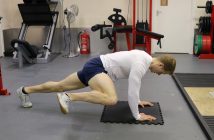Info Box
Manufacturer: Rogue Fitness
Price: Various
Level: Intermediate
Time: 30 minutes
Working out using a kettlebell is a fantastic way to stay in shape. The versatility of the equipment means you can get a mixed cardiovascular and muscular strength workout in one. This makes it popular to save time for busy individuals that need a quick way to keep fit.
The cardio bonuses from using the kettlebell are in that it is low impact, rather than spending time pounding the pavement or treadmill that might have a negative impact on joints, the kettlebell sees to improve joint stability, proprioception and strength.
In terms of muscular benefits the biggest bonus from the kettlebell is that nearly all movements are thought as of compound movements, this means they occur using 2 or more joints. This increases the recruitment of muscles and consequently the ability to build muscle and burn fat.
Another great benefit of kettlebell training is that it can be done almost anywhere and you only require the kettlebell itself. Anyone can use it to give themselves a full body workout, or target areas they wish to improve. This article outlines some of the most effective lower body kettlebell exercises.
Another great benefit of kettlebell training is that it can be done almost anywhere
Whilst using the kettlebell there is a position – racked – that is used in a lot of different movements. This is simply standing upright holding the kettlebell in one hand with the elbow tucked into the torso and hand approximately 45-degrees to the chest, the bell sat on the outside of the forearm. This position is often used in many exercises so is good to be aware of. Another point of interest is the different parts of the kettlebell, the ball itself is called the ‘bell’, the upright metal bars are the ‘horns’ and the top section the ‘handle’.
If you’re considering buying your own kettlebell, a word of advice regarding weight. It’s tempting to go out and buy a very heavy kettlebell, but we’d recommend against this, especially for a beginner. As a starting point, we’d recommend guys consider a 12Kg kettlebell as an entry-level weight. For the ladies, we’d suggest 6Kg, maybe even 4Kg.
With any kettlebell exercise, form is more important than the number of reps. Spend some time perfecting your form. Form is important to avoid injury.
 Before you continue, please remember that you need to warm up.
Before you continue, please remember that you need to warm up.
 If are are unsure about some of the terms used in this article, it’s worth having a quick read through our Glossary of Terms before you get started with your workout.
If are are unsure about some of the terms used in this article, it’s worth having a quick read through our Glossary of Terms before you get started with your workout.
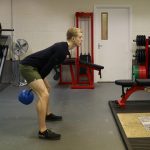
2-arm Swing. Click for full exercise
x
01
2-arm Swing
Assume a half squat position holding the kettlebell by the horns between your legs. Pop your hips forward creating a large amount of propulsion to swing the kettlebell forward. You should be aiming for the kettlebell to be head height at the highest point.
Target: 10 swings (beginner), 30 swings (intermediate), 50+ swings (advanced)

Lateral goblet squat start. Click for full exercise
x
02
Lateral Goblet Squat
Holding the kettlebell close to your chest take a large step with one foot to that side and squat down so your elbows touch your knees. Drive back up and to the starting position with the outside foot.
Target: 10 squats (beginner), 20 squats (intermediate), 30+ squats (advanced)

Lunge start. Click for full exercise
x
03
Lunge
Holding the kettlebell close to your chest take a step forward with one leg and drop into a lunge position, creating a 90-degree angle at both front and back knees. Keep toes pointing forwards and try to keep the back knee off of the ground to ensure tension is kept throughout the movement. Push back up with the front leg to the starting position.
Target: 5 lunges per leg (beginner), 10 lunges per leg (intermediate), 15 lunges per leg (advanced)

Clean. Click for full exercise
x
04
Clean
Start this move stood with feet just wider than shoulder width. Place the kettlebell between your feet, so the handle is facing sideways. Grasp the handle with one hand whilst in a squat position. Drive through the quads to create the momentum to lift the kettlebell. As you drive up twist the hand and arm out and underneath the kettlebell until your stood upright and the kettlebell is racked, resting on the outside of your forearm.
Target: 5 cleans per arm (beginner), 10 cleans per arm (intermediate), 15 cleans per arm (advanced)
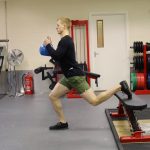
Bulgarian Split Squat. Click for full exercise
x
05
Bulgarian Split Squat
Holding the kettlebell close to your chest, stand in front of a step or bench facing away and place one foot behind onto the apparatus. With the other leg, step forwards slightly and squat down and forwards, this will require more stabilisation and control that a regular squat or lunge. Push back upright with the front leg.
Target: 5 squats per leg (beginner), 10 squats per leg (intermediate), 15 squats per leg (advanced)
Tip: If you want to make it more difficult, hold two kettlebells in the racked position.
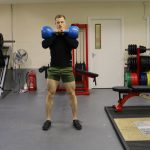
Front Squat. Click for full exercise
x
06
Front Squat
Folding the kettlebells in the racked position bend at the hip and knee and sit back into a squat position. Push back to the upright position keeping the weight through your heels.
Target: 10 squats (beginner), 20 squats (intermediate), 30+ squats (advanced)
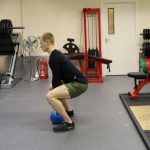
Deadlift. Click for full exercise
x
07
Deadlift
Like a traditional deadlift squat down keeping your back straight and shoulders back, grasp the kettlebell by the handles and stand straight up. Keep your arms locked and your back straight throughout the movement, try and move the kettlebell in a straight vertical motion, lower back to the floor under control.
Target: 5 deadlifts (beginner), 10 deadlifts (intermediate), 15 deadlifts (advanced)
Tip: You can make this more more difficult by adding a second kettlebell.
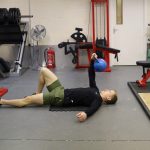
Turkish Get-Up. Click for full exercise
x
08
Turkish Get-Up
Lie on the ground with the kettlebell in your right hand outstretched above your chest, your right knee bent and your left arm extended to your side. Sit up by putting your weight through your left elbow and hand, keeping your eyes on the kettlebell. Drive through your left hand and right foot to raise your body into a bridge position.
Next bring your left leg back under your body into a kneeling lunge position. From here drive through your right foot and stand up. Reverse the actions in order to return to the start position. One rep is from the floor to standing and back to the floor.
Target: 3 get-ups per arm (beginner), 6 get-ups per arm (intermediate), 10 get-ups per arm (advanced)
Those are 8 of the most effective lower body movements but will also work parts of your upper body too, one of the great bonuses of the kettlebell – the ability to work the entire body with one move.
If you were after a workout to combine these movements together you could look to do 12 – 15 repetitions of movements 1 to 7, with 45 seconds rest between each movement, then perform 3 – 5 turkish get-ups on each side. That alone may be enough to give yourself a good workout in a short space of time, however if you need some more volume, rest 2 minutes after and repeat the program again.
This shows some of the different movements available when using a kettlebell to train and the exciting and fun ways to change your workouts.
 Before you finish, remember that you should spend time cooling down.
Before you finish, remember that you should spend time cooling down.
Post Views: 3,369
![]() Before you continue, please remember that you need to warm up.
Before you continue, please remember that you need to warm up.![]() If are are unsure about some of the terms used in this article, it’s worth having a quick read through our Glossary of Terms before you get started with your workout.
If are are unsure about some of the terms used in this article, it’s worth having a quick read through our Glossary of Terms before you get started with your workout.![]() Before you finish, remember that you should spend time cooling down.
Before you finish, remember that you should spend time cooling down.










